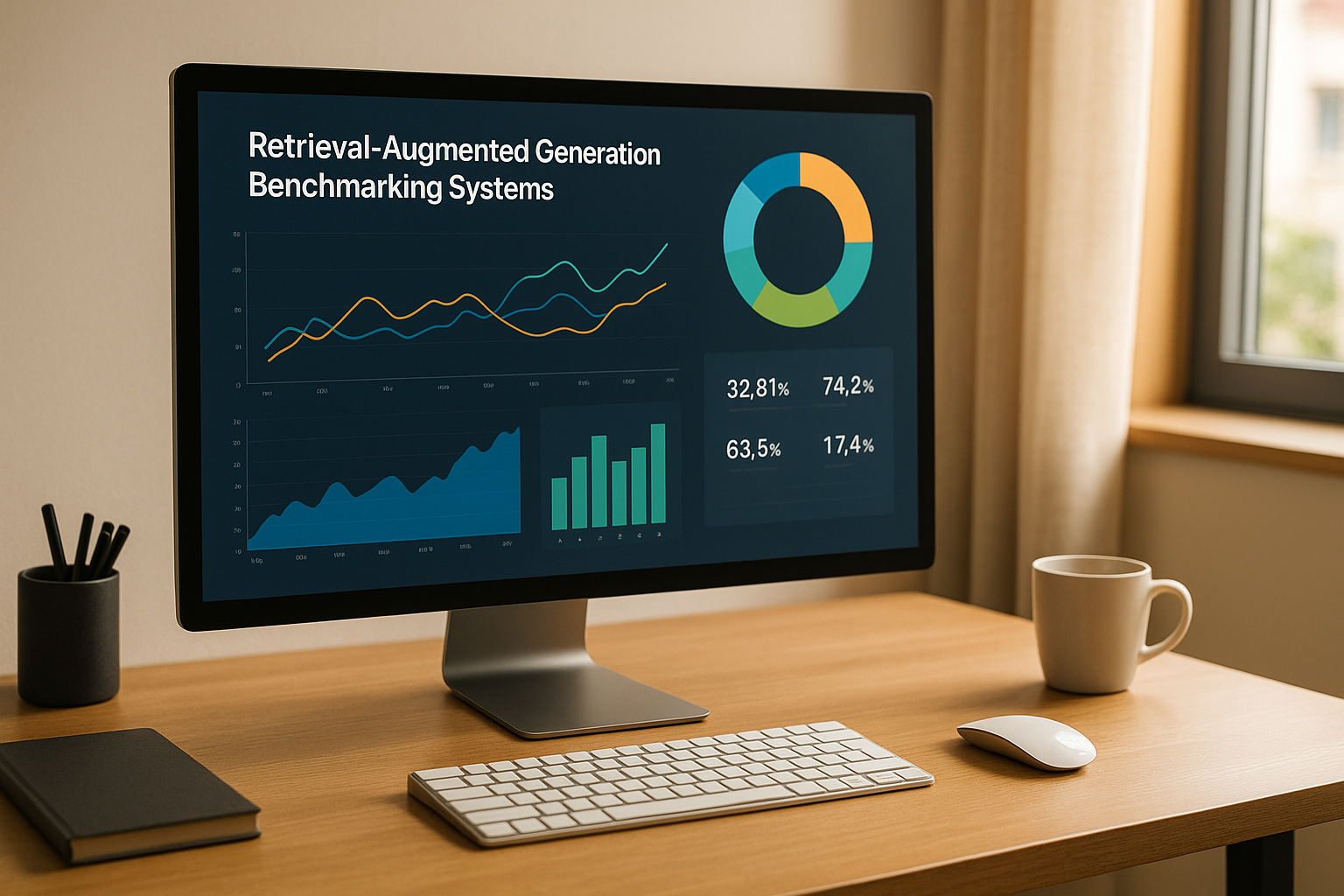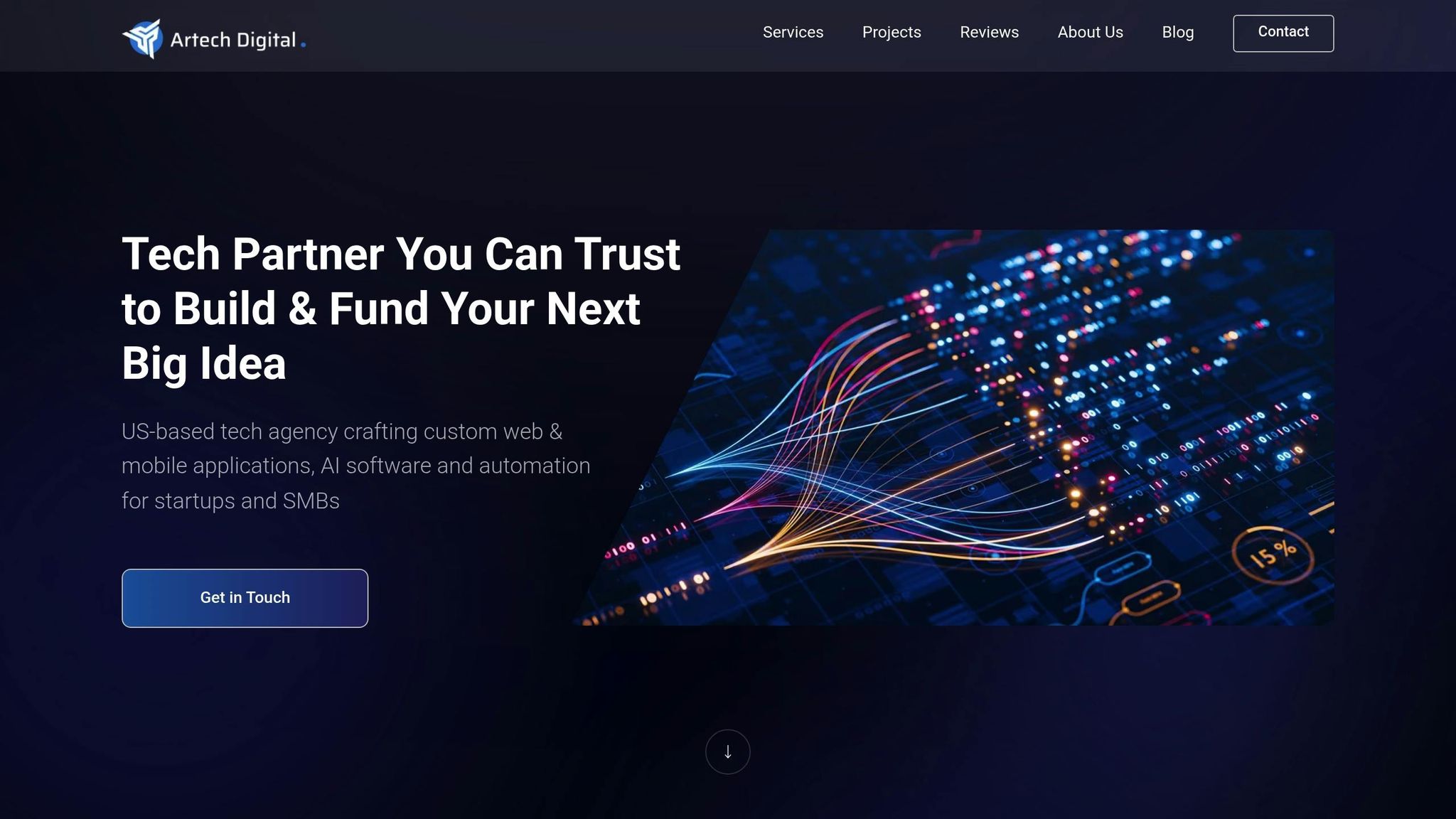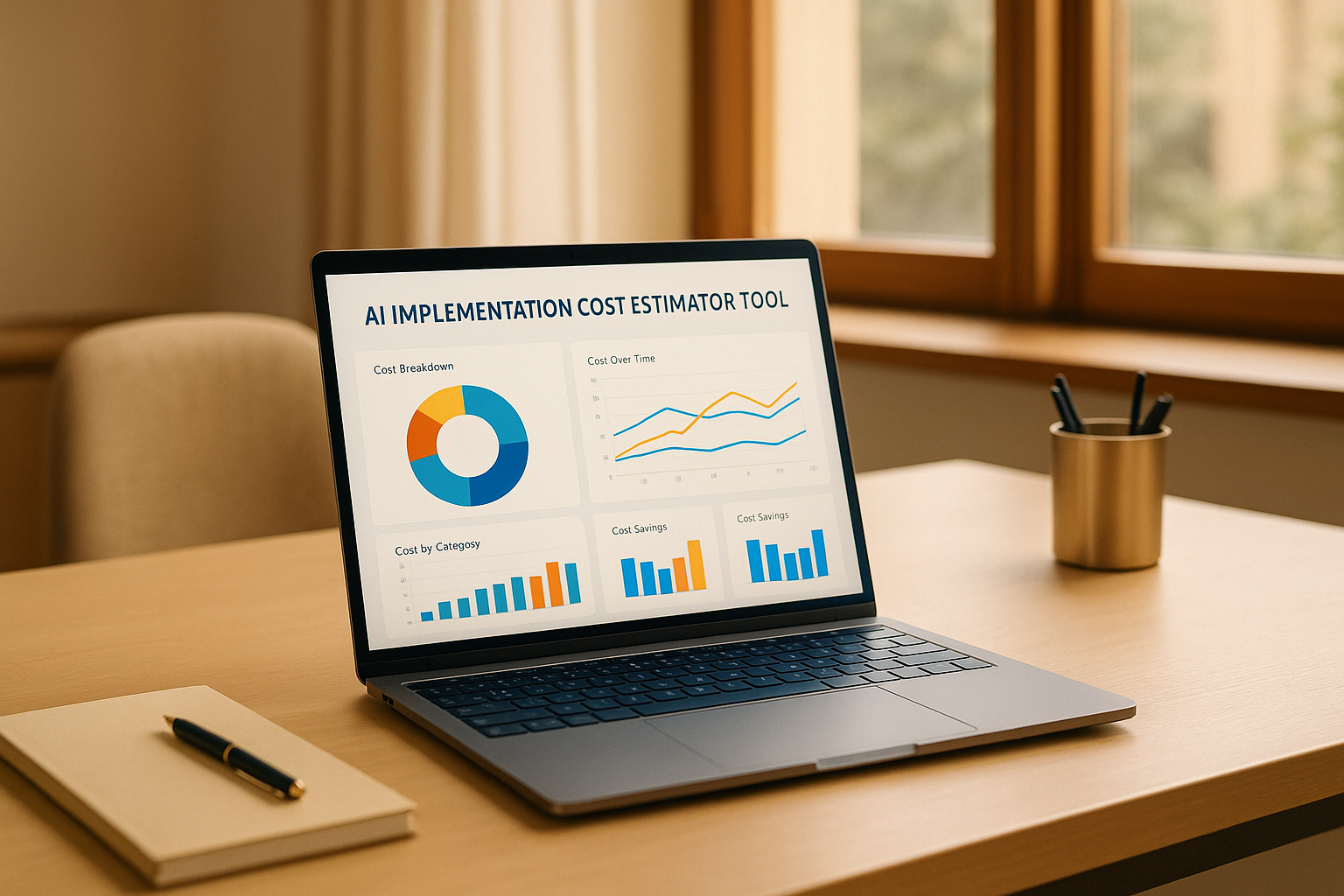
Retrieval-Augmented Generation (RAG) systems combine large language models with real-time access to external knowledge, making them crucial for generating accurate, dynamic, and contextually relevant responses. Benchmarking these systems ensures they perform efficiently, reducing errors like hallucinations and improving user trust.
Regular benchmarking, combined with tools and strategies, ensures RAG systems deliver accurate, fast, and reliable results, meeting both technical and user expectations.
Evaluating the performance of a Retrieval-Augmented Generation (RAG) system involves assessing both how well it retrieves relevant information and the quality of its generated outputs. Interestingly, the retriever's performance is the backbone of a RAG system, contributing to about 90% of its overall effectiveness.
"Evaluation and creation are separate skills." - Mohamed EL HARCHAOUI
To make these evaluations meaningful, it's essential to define system goals that align with user needs and business objectives. These metrics form the foundation for a thorough performance review, paving the way for deeper evaluations.
Retrieval metrics fall into two categories: order-unaware and order-aware. The choice between these depends on whether the focus is purely on the relevance of retrieved documents or also on their ranking.
Order-Unaware Metrics evaluate relevance without considering the order of results:
Order-Aware Metrics take the ranking of relevant documents into account:
Graded Relevance Metrics go beyond binary relevance to evaluate varying degrees of relevance:
Assessing the quality of generated content is just as important as retrieval accuracy. While traditional metrics like BLEU and ROUGE provide a starting point, they often fall short in capturing context relevance and factual correctness.
Traditional Metrics offer baseline evaluations:
Modern Semantic Metrics provide deeper insights:
A critical challenge in RAG systems is managing hallucination - when the system generates inaccurate or fabricated information. Effective hallucination detection and mitigation are essential for maintaining trustworthiness.
Detection Techniques vary in accuracy, cost, and complexity:
| Technique | Accuracy | Precision | Recall | Cost | Explainability |
|---|---|---|---|---|---|
| Token Similarity Detector | 0.47 | 0.96 | 0.03 | 0 | Yes |
| Semantic Similarity Detector | 0.48 | 0.90 | 0.02 | K | Yes |
| LLM Prompt-Based Detector | 0.75 | 0.94 | 0.53 | 1 | Yes |
| BERT Stochastic Checker | 0.76 | 0.72 | 0.90 | N+1 | Yes |
The LLM prompt-based detector strikes a balance between accuracy and cost, while the BERT stochastic checker offers high accuracy. Combining methods often yields the best results: for instance, using a token similarity detector to catch obvious hallucinations, followed by an LLM-based approach for more nuanced cases.
"RAG helps mitigate all of the above classes of hallucinations on its own (relative to fine-tuning a single generative model) by feeding only relevant data into the model at query time and telling the LLM only to use the data provided to it from the retrieval step." - Vectara
Mitigation Strategies to reduce hallucination rates include:
The importance of robust detection cannot be overstated. For example, Air Canada faced legal trouble when their RAG chatbot inaccurately described their refund policy, leading to a court loss. This highlights the need for rigorous evaluation and continuous monitoring of RAG systems.
When selecting detection methods, organizations must weigh factors like computational resources, accuracy needs, and cost to ensure reliable and trustworthy outputs. By doing so, they can build systems that users can confidently rely on.
When it comes to improving and validating Retrieval-Augmented Generation (RAG) systems, selecting the right datasets is absolutely critical. These datasets and benchmarks help measure how well a system performs and identify areas for improvement. Standard benchmarks offer a way to compare performance across the industry, while custom datasets ensure the evaluation aligns with your specific business needs. Starting with these established benchmarks provides a solid foundation before tailoring them to unique scenarios.
There are several widely recognized datasets that have become essential for assessing RAG systems. Each focuses on different aspects of retrieval and generation.
Here’s a quick overview of these benchmarks:
| Dataset | Scale | Primary Focus | Best For |
|---|---|---|---|
| Natural Questions | 16M documents | Real user queries | General-purpose evaluation |
| MS MARCO | 8.8M passages | Enterprise search | Large-scale retrieval testing |
| HotpotQA | Multi-document | Multi-hop reasoning | Complex query handling |
| TriviaQA | Multi-paragraph | Evidence | Fact-intensive applications |
| BEIR | 18 task types | Cross-domain robustness | Evaluation |
While standard benchmarks provide a great starting point, they don’t always address the specific needs of your business. Custom datasets tailored to your industry or use cases can help ensure that evaluations reflect real-world performance.
To start, define clear objectives for your evaluation. Consider factors like relevance, diversity, and fairness. Building a cross-functional team - including data scientists, domain experts, ethicists, and legal professionals - can help tackle issues like bias and ethical concerns that standard benchmarks might miss.
Dive into metadata from various sources to ensure your data is up-to-date and contextually accurate. Documenting details like authorship and context can help you understand how your dataset stacks up against standard benchmarks. Use statistical analysis and visualizations to spot patterns, anomalies, or gaps that could affect performance in real-world scenarios.
When creating custom datasets, it’s crucial to identify any gaps. For example, are all your business scenarios, customer inquiries, and product details represented? Missing key areas could lead to underperformance in practical applications.
Ensuring diversity in your dataset and reducing bias are essential for consistent and fair system performance. Bias detection techniques can help evaluate how well your system performs across different demographics, product lines, or service areas.
Analyzing your content for biased language, stereotypes, or toxic elements is a good starting point. Subgroup analysis can also highlight performance disparities among user groups or content categories. Ethical reviews help ensure your dataset respects privacy, consent, and company values. Testing your RAG system in specific scenarios can reveal whether it generates unbiased and accurate responses across diverse contexts.
To address bias, consider enriching your dataset with diverse sources to fill gaps. Remove outdated, irrelevant, or biased content, and use techniques like oversampling or undersampling to balance representation. Sensitive variables like race, gender, or age should be excluded from training datasets to avoid introducing bias. Bias mitigation strategies, such as correction techniques and balanced sampling, can also help.
Regular audits and automated tools can maintain fairness and quality over time. These tools can track bias levels, detect toxic content, and allow users to report any issues they encounter. Pre-processing the data is another key step - balancing representation through oversampling or undersampling ensures a more equitable dataset distribution.
Interestingly, retrieval-augmented models have shown a 30% reduction in factual inaccuracies and hallucinations compared to static language models. Ongoing evaluation across different subgroups, combined with human oversight and automated tools, ensures that biases are caught and addressed before they impact users.
Once you've defined your metrics and selected your datasets, it's time to design experiments that produce reliable and actionable insights. A well-structured experimental setup allows you to pinpoint which changes enhance your RAG system and which don't, by isolating variables and measuring their impact under controlled conditions.
Benchmarking in RAG systems thrives on controlled experimentation, where only one variable is adjusted at a time. This ensures that any changes in performance metrics can be directly attributed to that specific adjustment. Start by creating a diverse test dataset filled with high-quality questions. These should include variations in phrasing and complexity to reflect real-world scenarios. Work with stakeholders to develop "golden" question inputs that represent key use cases, and pair them with a reference dataset of expected outputs to act as your evaluation benchmark.
Run your current RAG configuration against this test dataset to establish a baseline. Then, tweak one component - such as the retrieval algorithm, embedding model, or generation parameters - and re-run the test to see how it affects performance. Store the results in a shared repository to make it easy to track changes and compare configurations over time.
After completing these controlled tests, analyze the results across your metrics to identify trade-offs and determine which adjustments provide the best balance.
Beyond testing individual components, comparative analysis helps you evaluate the trade-offs between different RAG configurations. For example, you can compare sparse TF-IDF retrievers with dense embedding models or experiment with various generation models. In one study, researchers tested 100 world knowledge queries across 2,512 context document chunks, varying retriever types, the number of retrieved documents, generation models, and prompt templates. They found that advanced models using chain-of-thought prompts had the lowest hallucination rates.
Here’s an example of some trade-offs observed during comparative analysis:
| Configuration Element | Performance Impact | Trade-off Considerations |
|---|---|---|
| Dense vs. Sparse Retrieval | 25% improvement in relevance for specialized tasks | Higher computational costs |
| Document Count (2 vs. 4) | Better context coverage | Increased latency and token usage |
| Generation Model | Lower hallucination observed with advanced models | May incur higher operational costs |
For instance, embedding models tailored for semantic search improved retrieval relevance by 25% in specialized tasks. Additionally, continuous optimization of RAG systems resulted in a 30% accuracy boost year-over-year. These findings highlight the importance of systematic comparative analysis in refining performance.
While technical benchmarks are essential, understanding the user experience requires A/B testing. This method splits users into two groups: one using the existing system (Group A) and the other interacting with the updated version (Group B).
Start A/B testing with a clear hypothesis and define primary metrics to measure the success of the changes. Include guardrail metrics to ensure the overall user experience remains positive. Run these experiments for 1–2 weeks to capture authentic user behavior and account for natural fluctuations. Ensure your test group represents your target audience by including users across key personas.
Collect both quantitative metrics and qualitative feedback to complement automated evaluations. Keep in mind that technical improvements don’t always directly translate to a better user experience. A/B testing helps you strike the right balance between system performance and user satisfaction.
After conducting detailed benchmarking experiments, the next step is to turn those insights into actionable improvements. This involves digging into the data, identifying patterns and bottlenecks, and crafting a clear plan to optimize your system's performance.
To analyze your benchmarking data effectively, focus on both the individual components and the overall pipeline of your RAG system. Break it down into its key parts - embedding model, retriever, reranker, and language model - to locate performance bottlenecks.
Pay close attention to patterns in the data. For example, relevance scores can show how well your retrieval system is surfacing the right information. If users frequently get irrelevant answers, it could mean your embedding model needs adjustment to better fit your domain. Similarly, accuracy metrics reveal how well the generation model synthesizes retrieved information, while hallucination checks expose whether your system is generating content that doesn’t exist in the source documents.
Changes in retrieval performance, such as a drop from 90% to 80%, might indicate that new documents aren’t being indexed properly. This kind of drift is best caught through regular monitoring.
Balancing speed and scale is also essential. A system that delivers perfect answers but takes too long to respond won’t meet user expectations, while one that’s fast but inefficient with resources can strain your infrastructure. For instance, Stanford's AI Lab found that using MAP and MRR metrics improved precision for legal research queries by 15%.
User feedback is another critical layer of analysis. Automated metrics can’t always capture the nuances of user experience, such as response tone or formatting. Linking technical performance data with user complaints can highlight areas where metrics fail to align with real-world needs.
These insights lay the groundwork for systematic optimization.
Once problem areas are identified, the next step is to optimize systematically. Focus on four main areas: data preparation, retrieval quality, prompt engineering, and model fine-tuning.
Data preparation involves cleaning and standardizing text, enriching metadata, and experimenting with chunk sizes. For example, combining text and image embeddings has shown measurable improvements in some systems.
| Optimization Area | Methods |
|---|---|
| Data Preparation | Clean data, standardize text, enrich metadata, adjust chunk sizes |
| Retrieval Quality | Test embedding models, combine methods, use contextual retrieval |
| Prompt Engineering | Design clear prompts, integrate retrieved documents, add response constraints |
| Model Fine-Tuning | Fine-tune on task-specific data, train embedding models |
Retrieval quality often yields the biggest gains. Fine-tune your embedding models using both dense and keyword-based methods to capture semantic nuances and precise matches. For instance, an online retailer enhanced its recommendation engine by integrating RAG with user behavior data and product descriptions, leading to a 25% boost in click-through rates and a 10% rise in conversions.
Prompt engineering focuses on crafting instructions that guide the language model effectively. Clear prompts, strategic use of retrieved documents, and constraints to avoid hallucinations can significantly improve accuracy. In fact, better prompt design has been shown to reduce factual errors by 30%.
Model fine-tuning is resource-intensive but can deliver transformative results. Training your model on task-specific data and optimizing embedding models for your domain ensures it captures the right semantics. One tech company improved its customer support chatbot by using RAG to draw from FAQs, manuals, and past support tickets, leading to faster and more accurate responses.
Even with these optimizations, continuous benchmarking is essential to maintain performance over time. Data drift, evolving user needs, and expanding document collections can all degrade system reliability if not addressed.
Regular monitoring helps catch these issues early. For example, as your document collection grows, your system might struggle to index new information effectively. Automated alerts, set up through custom scripts or RAG-specific evaluation tools, can notify you when key metrics fall below acceptable levels.
Quarterly benchmarking cycles provide a structured way to track progress. Update your test datasets regularly with sample questions and responses that reflect real-world usage, including multi-turn conversations, noisy inputs, and ambiguous requests. According to an Accenture survey, 75% of companies that implemented continuous RAG optimization saw a 30% annual improvement in accuracy.
The most effective strategies combine automated monitoring with human evaluation. While automated tools provide consistent baseline tracking, human reviewers can assess quality aspects that algorithms might miss. By linking live performance metrics with user feedback, you can ensure your system meets both technical and user satisfaction goals.
Version control for test suites is another valuable practice. It allows you to track changes over time and quickly identify when updates negatively impact performance. Running benchmarks after every major system change ensures that improvements are genuine and helps catch potential issues before they affect users.
Finally, regular benchmarking keeps your system competitive as industry standards evolve. What works well today might not meet tomorrow’s expectations. By maintaining consistent evaluation processes, you can ensure your RAG system continues to deliver high-quality results over the long haul.

Combining advanced benchmarking practices with expert AI solutions can significantly enhance the performance of RAG systems. Improving these systems requires specialized knowledge, and Artech Digital brings over 10 years of experience in crafting custom AI solutions, consistently tackling the challenges of benchmarking and optimizing RAG performance.
Artech Digital specializes in creating tailored RAG solutions, including AI agents, RAG deployment, fine-tuning, and private LLM implementations, all designed to meet specific business needs and align with industry standards.
For instance, Artech Digital developed an AI-powered legal chatbot for Dolman Law Group, automating case evaluations and answering FAQs. This solution has saved over 1,000 support hours monthly. Precision was critical here, as the legal domain demands high accuracy in responses.
Similarly, Hawaiian Beach Rentals leveraged a custom AI chatbot to handle booking inquiries and FAQs. This innovation not only saved 1,200+ support hours per month but also improved customer satisfaction.
"We had an excellent AI bot integrated into our web app, which was delivered promptly and performs superbly. This agency gets a perfect score of 10 out of 10!" - Monica, Founder - Klimt Creations
Artech Digital goes beyond off-the-shelf models by fine-tuning large language models to cater to specific industries. This approach ensures domain-specific accuracy and better results in retrieval and generation tasks. Their focus on continuous performance support ensures that these systems stay efficient and effective over time.
After implementing a custom RAG system, ongoing optimization is crucial to ensure its long-term value. Artech Digital provides continuous support to identify bottlenecks and apply optimization strategies, helping businesses maintain a competitive edge.
Their team augmentation services allow companies to bring in skilled AI and FullStack engineers when needed, without the commitment of permanent hires. This flexibility is especially helpful during intensive benchmarking phases, where having the right expertise can make a noticeable difference.
"Absolutely phenomenal work, I would highly recommend this agency. They have been one of the best I've ever hired. Very high quality process and deliverables." - Damiano, Chief Growth Officer - BrandButterMe
With over 50 completed projects and solutions that have saved clients more than 5,500 hours annually, Artech Digital has a proven track record of turning benchmarking insights into actionable improvements.
Artech Digital offers services tailored to businesses of all sizes and technical stages. Their 96%+ Job Success Score and 120+ verified 5-star reviews on platforms like Upwork and Fiverr highlight their consistent ability to deliver results.
For businesses seeking strategic guidance, their fractional CTO services provide executive-level AI expertise without the need for a full-time hire. This is particularly beneficial for companies planning long-term RAG benchmarking strategies that align with broader goals.
Artech Digital follows a three-phase process - Discovery & Road-Mapping, Build & Iterate, and Launch & Scale - ensuring that benchmarking is integrated at every stage of RAG system development. This structured approach supports the continuous improvement strategies explored throughout this guide.
Benchmarking RAG systems is more than just a technical exercise - it's a critical business practice that enhances performance and reduces costs. To do it right, you need a well-rounded approach that evaluates retrieval quality, generation accuracy, and practical metrics like latency and cost.
This isn’t a one-time task. Benchmarking should be an ongoing part of your strategy. Focus on key metrics such as accuracy, latency, cost, and user satisfaction. For instance, research from Stanford's AI Lab revealed that applying metrics like MAP and MRR improved precision in legal research queries by 15%. Similarly, OpenAI found that hybrid retrieval systems could slash latency by up to 50%. These examples show how effective benchmarking directly impacts performance.
Organizations that thrive in this space recognize the importance of constant monitoring and adaptation, especially as real-world data evolves over time. These insights underscore the value of expertise in turning benchmarking into tangible business results.
With over a decade of experience in optimizing RAG systems, Artech Digital combines technical know-how with business strategy to deliver continuous improvement. Their holistic approach covers every stage of benchmarking, from setup to ongoing performance monitoring.
Artech Digital’s process - Discovery & Road-Mapping, Build & Iterate, and Launch & Scale - ensures benchmarking becomes a seamless part of your RAG system's lifecycle, turning insights into measurable outcomes.
Their fractional CTO services provide executive-level AI expertise, aligning technical metrics with broader business goals. With a 96%+ Job Success Score and over 120 verified 5-star reviews, they bring both technical skill and business insight to every project.
"Really great. My official partner for AI" – Christian, Founder, Prime Digital UK
To tackle intensive benchmarking phases, Artech Digital also offers team augmentation services, giving you access to specialized AI engineers exactly when you need them.
To build on these insights, here’s what you can do now to strengthen your RAG system:
Partnering with Artech Digital can streamline this process. Their proven methodologies and industry experience - ranging from High Tech and Healthcare to Retail and Automotive - ensure they understand the unique demands of your field.
Investing in effective benchmarking transforms guesswork into actionable insights. It leads to more efficient help desks, fewer escalations, and AI systems that genuinely empower businesses. The payoff? Greater reliability, lower costs, and happier users.
When evaluating a Retrieval-Augmented Generation (RAG) system, it's crucial to measure both the quality of retrieved information and the accuracy of the generated responses. Here are the key metrics to consider:
Regularly tracking these metrics helps pinpoint areas for improvement, ensuring your RAG system produces reliable and accurate results.
To keep RAG systems running smoothly and producing reliable results, businesses need to focus on regular assessments and performance checks. This means tweaking models as needed, improving retrieval and ranking processes, and keeping data sources up-to-date to maintain relevance.
On top of that, refining query strategies and monitoring essential metrics can highlight areas that need attention. By staying ahead of changes and adjusting to new demands, businesses can ensure their RAG systems consistently provide accurate and dependable outcomes.
Using custom datasets to assess Retrieval-Augmented Generation (RAG) systems allows for more precise and task-focused insights. By aligning datasets with your specific domain or use case, you can better understand how these systems will perform in practical scenarios.
To build effective custom datasets, gather real-world questions and answers from your documentation or user interactions. Alternatively, you can create synthetic data using AI tools or work with domain experts to craft high-quality, relevant datasets. This ensures your evaluations are not only accurate but also closely aligned with your objectives.


